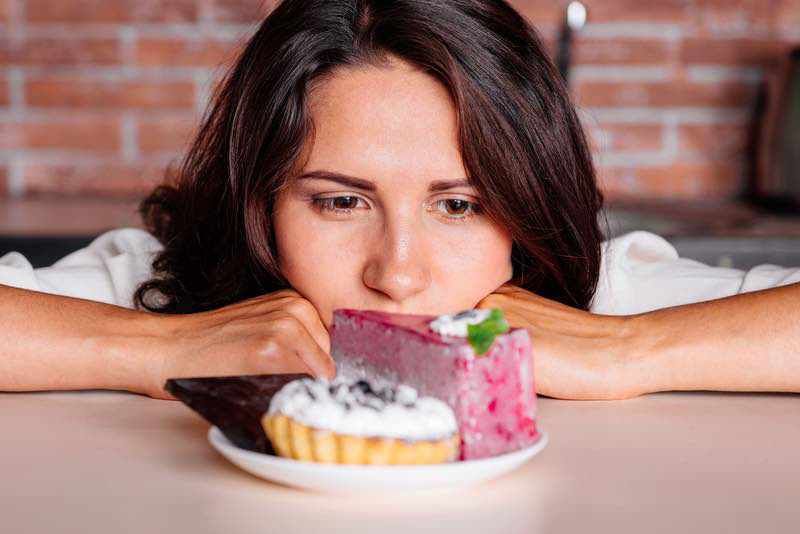Do you tend to eat more than you should when you’re feeling stressed, bored, sad, or depressed? Do you crave foods even when you’re not hungry? Can you relate? If so, then today you’re in the right place.
It’s called emotional eating, and it’s a very common and destructive habit.
Whether it’s a bag of chocolate cookies you eat when you’re stressed or potato chips you devour when you feel lonely, eating to fill an emotional void instead of real hunger can do you more harm than good.
Indulging once in a blue moon is no problem, but when you eat your emotions away regularly, it can cause serious health issues. Not does it only ends in overeating, but can also take a toll on your emotional well-being and self-esteem.
In today’s article, we’ll tackle what emotional eating is all about, dissect its causes and symptoms as well dive in into a few strategies that can help you put a stop to this scrooge forever. Let’s dig in.
The Definition
Though often dismissed as a lack of self-control or a sign of weakness, emotional eating is, in reality, the manifestation of a deeper psychological problem.
So What Is It All About?
Emotional eating refers to eating to feed your emotions instead of your body. It’s using food to soothe an unpleasant mood or feelings, trigger a pleasant mood, or keep a positive mood going. If you find yourself craving for food when you’re not physically hungry (as in you just had a big meal two hours ago), or every time you’re feeling down, you’re likely engaging in emotional eating.
You may swing through the drive-through after a stressful day at work, binge at night, because you feel bored, or deny yourself food because you feel that you’re not good enough. This devastating habit is pretty common, affecting people of all ages and backgrounds at one time or another.

The American Psychological Association reported that about 40 percent of adults admit to having overeating or eating junk food in the past month as a response to stress. About half these adults admit to giving in to their sweet tooth weekly or more. When you fall victim to emotional eating, you’ll likely reach for junk, high–calorie foods that are comforting but bad for you.
By turning to food to soothe yourself or using mouth pleasure to number yourself, you’ll be left feeling emotionally hollow. After the emotional eating episode is over, not only do the original issues remain, but you also feel guilty for indulging, and you get caught in a vicious cycle that get’s worse and worse.
As you can already tell, making a habit out of emotional eating can also make it hard to lose weight and/or keep it off. Nobody wants that.
Are You an Emotional Eater?
Now that you understand what emotional eating is, do you engage in it more than you should? Still unsure? Worry no more. I got you covered. Here are the main signs that you eat because of emotional strife.
- Do you often reach for food without realizing you’re even doing it?
- Do you consume more food than normal when you’re stressed?
- Do you keep eating even when you’re full?
- Do you often eat after an unpleasant experience?
- Do you feel the need to reach for food because you feel there’s nothing else to do?
- Do you reward yourself with food?
- Do you feel embarrassed, guiltily, or ashamed after eating?
- Do you often crave certain foods when you’re feeling down?
- Do you often keep on eating because you can’t tell what you are hungry for?
- Do you eat at unusual times or odd locations?
Answer yes to more than a few of these, and eating has likely turned into a coping mechanism for emotional strife instead of a way to fuel your body. In other words, you eat based on your emotions. It’s not all doom and gloom; however, as there are many measures you can take right now to combat emotional eating without starving to death.
How to Stop Emotional Eating

Understanding the phenomenon is just one piece of the puzzle. You also need practical strategies to help you overcome it—or else, you won’t break the cycle.
The following steps will help you get rid of this insidious habit.
Feel the Feelings Fully
Your first step toward overcoming emotional eating is to first accept your feelings—even the most unpleasant ones. At a glance, emotional eating stems from having a bad relationship with food, but it’s often the result of feeling powerless over your emotions. You don’t want—nor believe capable—to handle your emotions head-on, so you avoid them with mouth pleasure.
Here’s what to do. When you’re in a situation that often results in emotional eating, pause for a minute, take a few deep breaths and get a sense of the facts, then ask yourself: “what is it I’m craving for? Maybe you’re feeling stressed, depressed, lonely, rejected, or taken for granted. The key to breaking this cycle is to stay with yourself and allow yourself to fully accept those emotions.
Know Your Triggers
Understanding why you’re behaving this way allows you to get one step ahead of emotional eating so you can either steer clear of these traps or at least make you have a plan of action for the next time. Backtrace long enough, and you’ll undoubtedly uncover a distressing event that triggered the emotional cycle.
So what’s the reason behind your emotional eating? What’s causing it? Is it stress? Anxiety? Loneliness? Or Boredom? What does this feel like?
Start a Food Diary
Once you uncover a trigger, write it down. A fantastic tool is to use a food journal to keep track of your moods and eating habits and food intake.
Inside of your foot diary keep extensive details on the following:
- What you ate (or craved to eat)
- How much you ate
- What happened that made you upset
- Your feeling before eating
- Your feeling as you ate
- Your feelings afterward.
By keeping track, you’ll begin to notice patterns emerging between your eating habits and your emotional states. This is one of the best measures you can take to help you identify the patterns behind your emotional eating.
Maybe you always end up eating your emotions away after a stressful Monday at work or after spending time with a family member. Or perhaps you turn to comfort food when you attend family functions.
Turn Your Plan Into a Habit

Once you understand the triggers behind your emotional eating episodes, set up a healthy system to help you avoid indulging when things get tough.
Word of caution, though. We are human beings, and we’re not perfect. There always be some triggers that lay beyond our control. While you can take many measures to reduce your emotional strife, you’ll never be able to get rid of it completely—that’s just a part of the human experience.
That said, here’s a simple formula you can use:
Fill in the blanks “When (I feel X emotions). I will “do Y Behavior).
Examples of emotions that tend to be problematic for people include:
- Feeling tired
- Feeling stressed
- Feeling overwhelmed
- Feeling happy
- Experiencing relationship issues
- Feeling bored
- Feeling down
Alternative Healthy Behaviors Include:
- A walk around the block
- Going for a run or workout
- Listening to upbeat music
- Calling a friend
- Reading a book
- Getting a massage
- Watching your favorite show
- Taking a shower
- Taking a nap
There you have it. These tips and guidelines are some of the most efficient measures you can take right now to combat emotional eating and gain control over your eating habits without starving to death. You just need to start implementing them now and never deviate
Please feel free to leave your comments and questions.
About the Author:
David Dack is an established fitness blogger and running expert. When he’s not training for his next marathon, he’s doing research and trying to help as many people as possible to share his fitness philosophy. Check his blog Runners Blueprint for more info.



